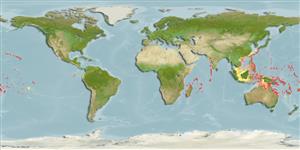Actinopterygii (ray-finned fishes) >
Perciformes (Perch-likes) >
Pomacentridae (Damselfishes) > Pomacentrinae
Etymology: Chromis: Greek, chromis = a fish, perhaps a perch (Ref. 45335). More on author: Smith.
Environment / Climate / Range
Ecology
Marine; reef-associated; non-migratory; depth range 3 - 65 m (Ref. 1602). Tropical, preferred ?; 31°N - 30°S
Indo-Pacific: East Africa to the Hawaiian and Pitcairn islands, north to the Ogasawara Islands, south to the Great Barrier Reef and New Caledonia. Primarily around oceanic islands.
Size / Weight / Age
Maturity: Lm ? range ? - ? cm
Max length : 7.5 cm SL male/unsexed; (Ref. 7247)
Dorsal
spines
(total): 12;
Dorsal
soft rays
(total): 12-14;
Anal
spines: 2;
Anal
soft rays: 12 - 14. Fish is rich golden brown, shading to purplish pink on lower head and chest. This species is distinguished from other similar Chromis by the large dark spot at the pectoral fin base.
Adults occur in clear lagoon and seaward reefs, usually in loose aggregations near caves and ledges. Abundant over branching corals and leeward coasts (Ref. 9710). Benthopelagic (Ref. 58302). Feeds on planktons (Ref. 89972). Oviparous, distinct pairing during breeding (Ref. 205). Eggs are demersal and adhere to the substrate (Ref. 205). Males guard and aerate the eggs (Ref. 205).
Life cycle and mating behavior
Maturity | Reproduction | Spawning | Eggs | Fecundity | Larvae
Oviparous, distinct pairing during breeding (Ref. 205). Eggs are demersal and adhere to the substrate (Ref. 205). Males guard and aerate the eggs (Ref. 205).
Allen, G.R., 1991. Damselfishes of the world. Mergus Publishers, Melle, Germany. 271 p. (Ref. 7247)
IUCN Red List Status (Ref. 115185)
CITES (Ref. 94142)
Not Evaluated
Threat to humans
Harmless
Human uses
Fisheries: of no interest; aquarium: commercial
More information
ReferencesAquacultureAquaculture profileStrainsGeneticsAllele frequenciesHeritabilityDiseasesProcessingMass conversion
Tools
Special reports
Download XML
Internet sources
Estimates of some properties based on models
Phylogenetic diversity index (Ref.
82805): PD
50 = 0.5000 [Uniqueness, from 0.5 = low to 2.0 = high].
Trophic Level (Ref.
69278): 3.0 ±0.24 se; Based on food items.
Resilience (Ref.
69278): High, minimum population doubling time less than 15 months (Preliminary K or Fecundity.).
Vulnerability (Ref.
59153): Low vulnerability (19 of 100) .
